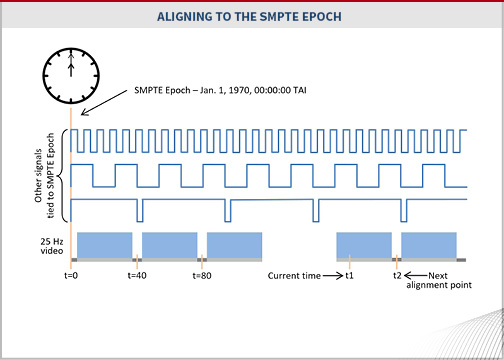With the transition to IP networks for all aspects of the signal processing path, accurate timing becomes more difficult, due to the fundamentally asynchronous, non-deterministic nature of packet-based networks. With Ethernet networks, which are inherently bi-directional, it is possible to distribute a common time signal using IEEE 1588 Precision Time Protocol (PTP) to every device without a separate overlay sync network. Each device can then accurately synchronize its internal clock to a single master clock which can then be used to accurately achieve media signal synchronization by means of the SMPTE Epoch.
To genlock a group of cameras or sync several microphones, two things are needed: a synchronized clock and a phase reference for each type of media signal. This second requirement is the purpose of an “epoch,” which is a (very) specific point in time that can serve as a common time reference for multiple signals. The SMPTE standard ST 2059-1:2015 “Generation and Alignment of Interface Signals to the SMPTE Epoch” provides this reference point, which is precisely 1970-01-01T00:00:00 TAI (Midnight, January 1st, 1970 International Atomic Time).
With an epoch, it becomes possible to calculate the phase of any periodic signal that can be referenced to that epoch. As defined in SMPTE and other standards, every media signal type (e.g. video or audio) has a defined alignment point. Every signal is then defined to have its alignment point occur simultaneously with every other signal’s alignment point at the precise moment of the epoch. From this common origin, the time of occurrence of any future alignment point for any signal can then be simply calculated as a multiple of the exact period of the signal. Using this basic concept, each device can align itself to a common, aligned reference simply by knowing the (precise) current time, as referenced to the common epoch.
Perhaps a quick example will help to explain this concept. Consider a 25 Hz SD video signal that has a period of 40 msec. As defined in ST 2059-1, the alignment point for the digital version of this signal is horizontal sample 732 of line 1 of this video signal. By definition, this alignment point occurred precisely at the time of the epoch. Another alignment point occurred exactly 40 msec later, followed by another one in at 80 msec, and so forth, as shown in Figure 2. To get in phase with this signal, all that a device needs to do is calculate how many milliseconds have occurred since the epoch, and then divide the result by 40. The remainder of this division gives the number of milliseconds since the last occurrence of the alignment point (shown as t1 in figure 2), which can in turn be used to calculate the time when the next alignment point will occur (t2 in figure 2). Then, all a device needs to do is align its internal video sync reference to that alignment point, and, presto, it becomes synced to every other device referenced to the common epoch.
For additional information about precision timing, its benefits, and applications download It’s About (Precision) Time white paper
Related Solutions: Quarra PTP Ethernet switches

